Network Planning And Design Tools
We are reader supported and may receive a commission when you make purchases using the links on our site
6 Best Network Capacity Planning Tools for 2021
Discover which network management software vendors provide the best network capacity planning tools. In-depth reviews plus links to free tools & trials.
@VPN_News UPDATED: August 4, 2021
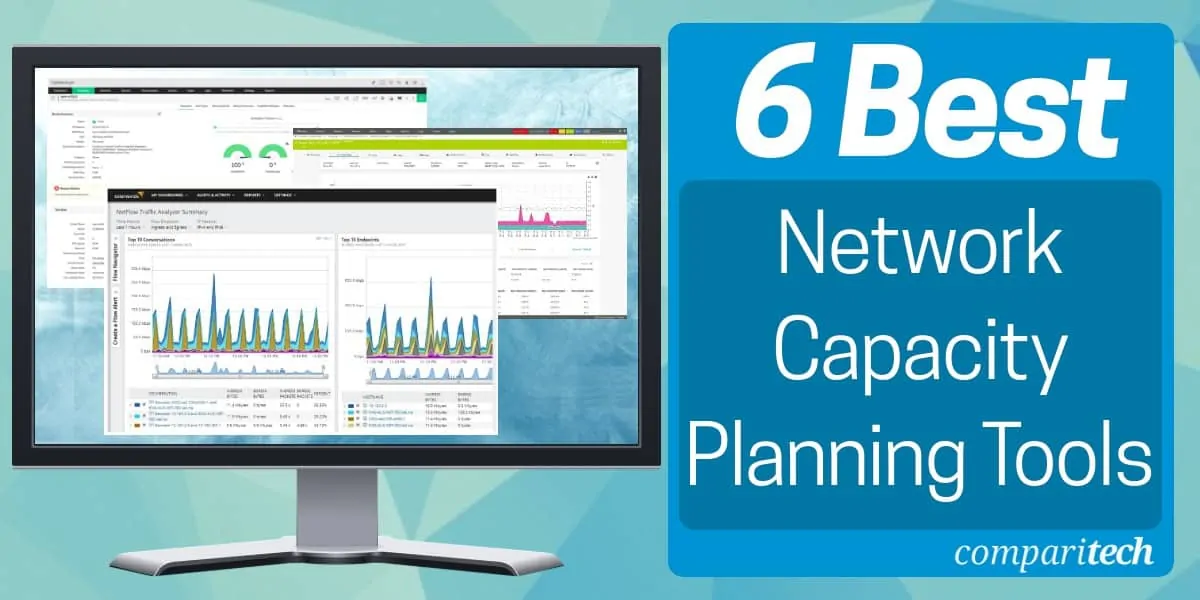
Networks evolve and scale over time and any changes, additions, or disruptions to a network or its operating conditions can have long-lasting effects. In a previous post, we discussed network capacity planning in-depth and look at the best practices for getting it right.
In this post, we focus on network management tools that can double up as network capacity planning tools.
Here's our list of the best network capacity planning tools:
- SolarWinds Network Bandwidth Analyzer Pack EDITOR'S CHOICE A bundle that includes the3SolarWinds Network Performance Monitor and the SolarWinds NetFlow Traffic Analyzer. Both tools run on Windows Server. Start 30-day free trial.
- SolarWinds Flow Tool Bundle (FREE TOOL BUNDLE) Free gift of the network tools from SolarWinds. These interact with Cisco routers.
- Paessler PRTG Network Monitor All-in-one monitoring package that covers network servers, devices, and applications. Installs on Windows Server.
- ManageEngine OpManager Plus Network device monitoring and traffic analysis in one bundle. Runs on Windows Server and Linux.
- Nagios XI Extendible network monitoring tool with a large and active user community. Runs on Linux.
- WhatsUp Gold with Network Traffic Analysis Add-on WhatsUp Gold is a network performance monitor that runs on Windows Server. Extend it with the Network Traffic Analysis add-on for capacity planning.
The Best Network Capacity Planning Tools
You need a proficient capacity planning tool in order to support the decision makers in your business when a new project is proposed.
That tool needs the following attributes:
- Integration with network monitoring software
- QoS capabilities
- Time-based analysis
- Link visibility and end-to-end connection analysis
- Traffic replays
- Storage of historical data
- Reporting capabilities
- Data visualizations
1. SolarWinds Network Bandwidth Analyzer Pack (FREE TRIAL)
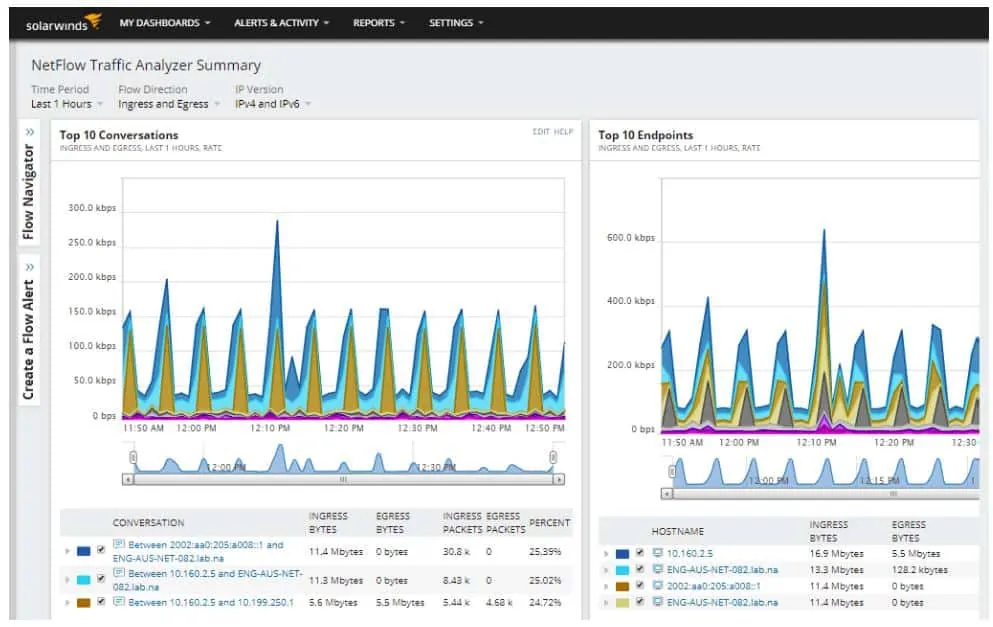
SolarWinds produces the industry-leading Network Performance Monitor. This tool tracks the health of network devices. When you look into network capacity planning, you also need the SolarWinds NetFlow Traffic Analyzer, which examines network link performance. You can get these two tools together in the Network Bandwidth Analyzer Pack.
The Network Performance Monitor starts off with a network scan. This gives your baseline of network equipment capacity. The monitor runs continuously and tracks the status of network devices. This includes information on the throughput of data. Each device agent will raise an alert if the demands on that piece of equipment approach its full capacity. This monitoring continues and logs when queuing occurs – that indicates that the device has become overloaded. So, after running the Network Performance Monitor for a few days, you will have all of the preliminary baseline information that you need to perform network capacity planning.
The NetFlow Traffic Analyzer has a confusing name. NetFlow is the name of a network equipment reporting system designed by Cisco Systems. Other equipment manufacturers use NetFlow, but it is not a universal standard. So, you may be discouraged from buying this tool because you don't want your equipment purchasing options to be limited to those devices that implement NetFlow. Don't worry. The NetFlow Traffic Analyzer is also able to receive other network equipment messaging protocols. These include J-Flow from Juniper networks and NetStream, which is used by Huawei devices. Recognition of the manufacturer-neutral sFlow and IPFIX protocols are also built into the NetFlow Traffic Analyzer. This tool will report on the total capacity of each link in your network and also give you live reports on bandwidth usage. This information can be recorded for analysis.
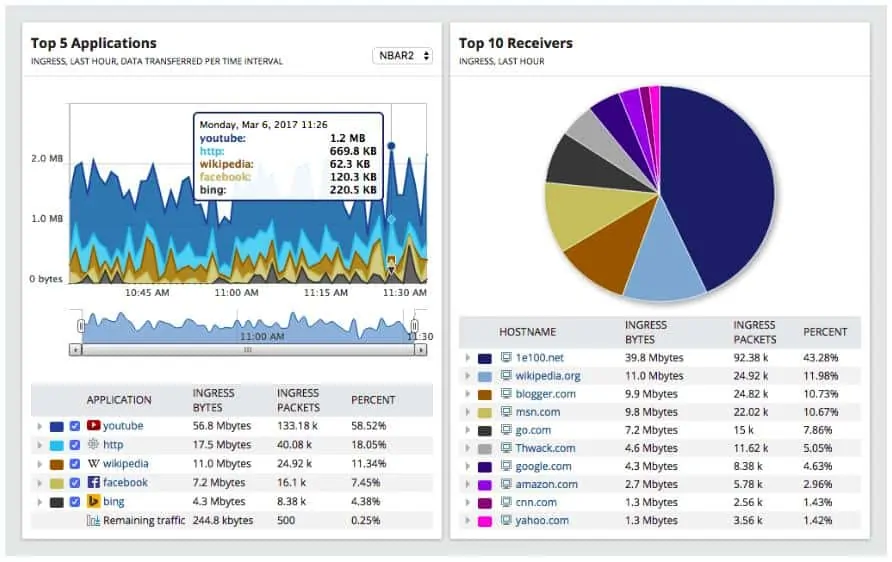
The Network Performance Monitor and the NetFlow Traffic Analyzer are built on a common platform, so they can exchange data; there are some functions in the dashboard to which both modules contribute. The PerfStack analyzer is one of these. This enables you to build up a visual stack showing supporting services so that you can spot the source of network performance problems. This is an example of the visual tools that SolarWinds provides with this software pack. Another great feature is the network map, which can be customized and is based on live data. The network map shows traffic capacity utilization and makes it easy to see network traffic throughputs at a glance. A wireless heat map shows the signal footprints of your WiFi routers, which you can show on the actual layout of your offices if you upload floor plans.
The NetFlow Traffic Analyzer is able to track CBQoS, so you can isolate any traffic when you are trying new software and network layouts. This feature is also useful for VLAN implementations that run your voice traffic over your data network. If you are looking for spare capacity, identifying types of traffic gives you traffic-shaping options.
Other traffic attributes that the NetFlow Traffic Analyzer gives you include the ability to identify traffic by protocol or port number. Both the Network Performance Monitor and the NetFlow Traffic Analyzer can track the capacity utilization of wireless networks. The combo pack of tools can also reach out across the internet to cloud services and remote sites, logging all of the offsite services and equipment that your business uses.
Pros:
- Great interface that balances visualizations and key insights well
- Highly customizable reports, dashboards, and monitoring tools
- Uses simple QoS rules for quick traffic shaping
- Built with large networks in mind, can scale to 50,000 flows
- Available for both Linux and Windows
Cons:
- Is a highly specialized suite of tools designed for network professionals, not designed for non-technical users
The SolarWinds Network Analyzer Pack installs on Windows Server environments. It isn't free. However, you can get the pack on a 30-day free trial.
EDITOR'S CHOICE
Both of the tools in the SolarWinds Network Analyzer Pack include great visualizations in the dashboard. These include charts, graphs, histograms, and dials, all of which are color-coded to show you statuses at a glance. All traffic data is shown live in the dashboard, but it can also be saved for analysis. The package ships with standard reports that will cover just about all of your presentation needs, but the system also allows you to create your own customizable reports.
Start 30-day Free Trial: solarwinds.com/network-bandwidth-analyzer-pack
OS: Windows Server 2012 R2 or later
2. SolarWinds Flow Tool Bundle (FREE TOOL BUNDLE)
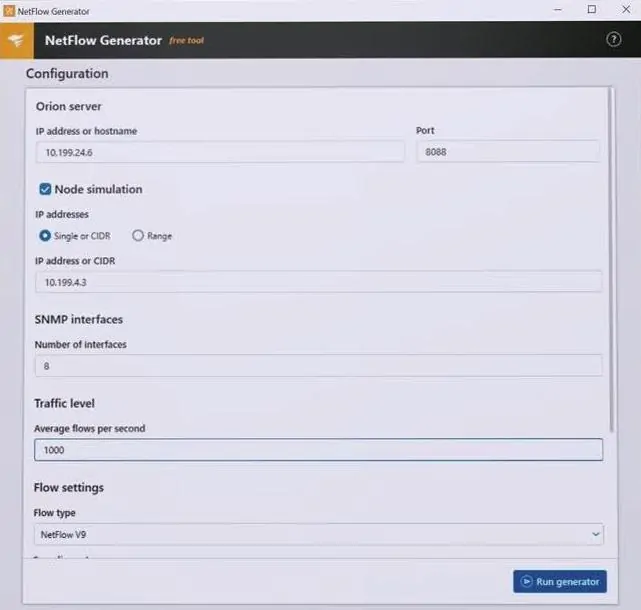
The SolarWinds Flow Tool Bundle is a free set of tools for testing network traffic volumes. The tool works with NetFlow v5 messaging through Cisco routers. NetFlow was invented by Cisco Systems to aid in the analysis of traffic patterns on networks. It can capture IP headers and send them to a collector for viewing and storage and it can also produce packet summary data on aggregated packet traffic.
The great advantage of the NetFlow system is that it doesn't dump out all of the contents of the packets traveling around the system, so there is no danger that network admin staff will break the confidentiality of the company's data while analyzing traffic flows. One downside of leaving NetFlow on all the time is that it will create extra traffic on the network and also generate large volumes of data that will need to be stored.
One of the elements of the Flow Tool Bundle helps you manage the activation of NetFlow on your routers. The other two tools in the pack aid with network testing. These three utilities are:
- NetFlow Configurator
- NetFlow Replicator
- NetFlow Generator
The NetFlow Configurator acts as an interface to your Cisco routers so that you can turn NetFlow on and off easily and tell the routers where to send the Netflow data. This saves you from having to visit each router, log in to it and click down through the menu to find the NetFlow function. So, the NetFlow Configurator is a very simple tool, but it will save you a lot of time.
The NetFlow Replicator lets you replay traffic data through your network. This will help you to see what happened on the network while you were occupied with other tasks. This is a great way to see errors, bottlenecks, and traffic slowdowns. If the problem was caused by a temporary fault on a network device, those traffic challenges won't arise during the rerun. If the problems were caused by a traffic surge. You will be able to see it and take action accordingly.
The NetFlow Generator will create fake traffic for you so that you can see how your current network infrastructure will cope with increased load. Although you should be able to calculate this on paper by adding expected increases in volume to your current throughput, actually seeing those traffic patterns live will make sure that you haven't overlooked any part of the system. This is also a good exercise to test the capacity and efficiency of your load balancers, firewall, and network monitoring software to make sure that they can all cope with planned expansions in demand.
Pros:
- Completely free bundle of tools
- Great for testing Cisco equipment and troubleshooting NetFlow messaging
- Can test networks with simulated traffic prior to going live
- Allows you to replay specific traffic patterns to replicate errors
Cons:
- Graphing charts are a bit barebones
The three utilities on the Flow Tool Bundle will give you a free method to plan your network capacity and analyze any shortcomings in your current set up.
SolarWinds Flow Tool Bundle Download 100% FREE Tool Bundle
3. Paessler PRTG Network Monitor
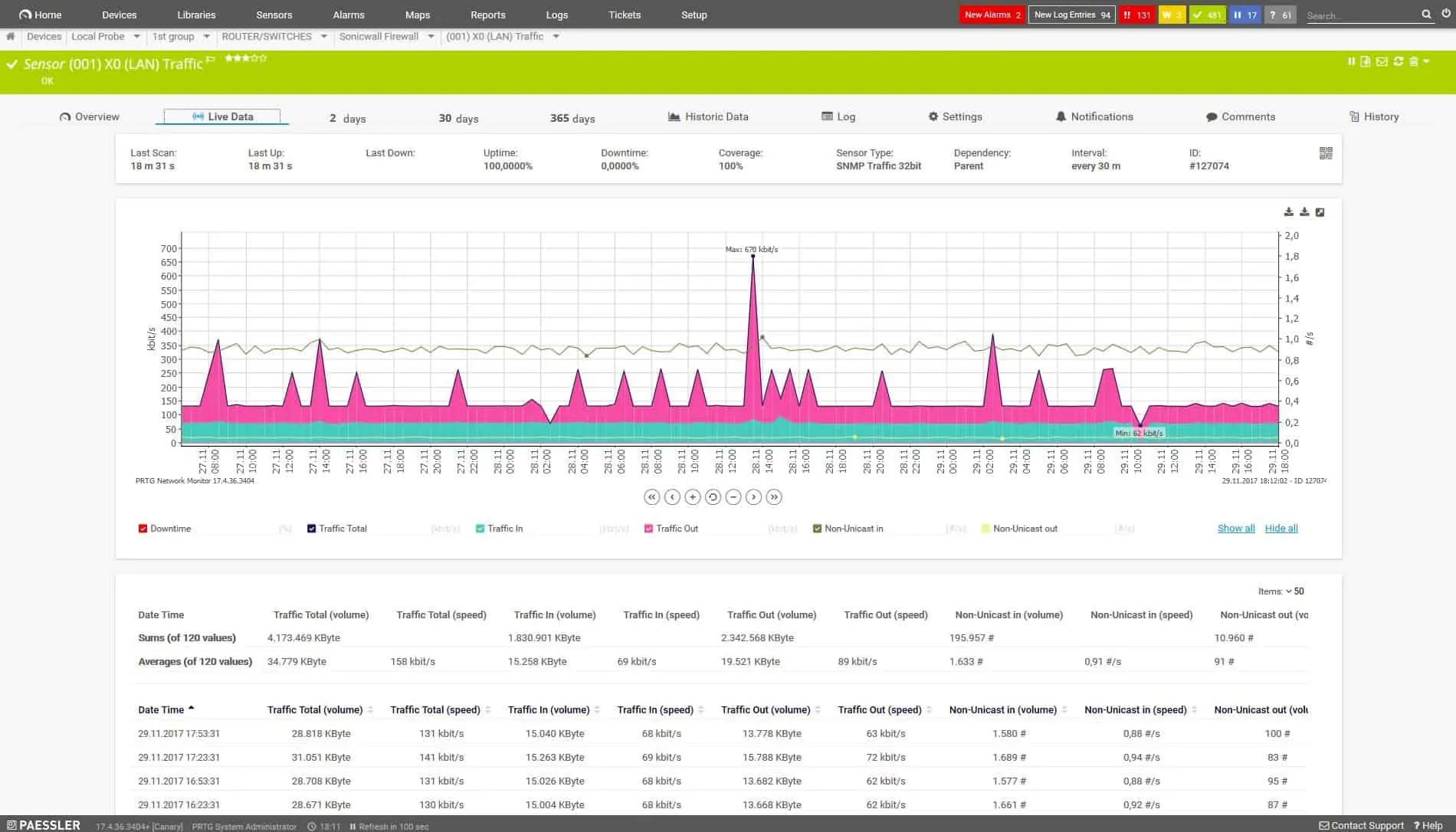
Paessler produces an all-in-one solution to infrastructure monitoring and called itPRTG. This tool includes both network device monitors and traffic analysis as well as server monitoring.
You can choose to install PRTG on-premises or use it as a cloud service. Even if you go for the online version, you will have to install some software on one of your servers. This is a data collection agent and it runs on Windows Server, as does the full package if you opt for the on-site version.
The first task of PRTG after you activate it is to scan your network and create a device inventory. It will also create a network map from the information it gathers on switches and routers. The maps that PRTG generates are impressive. You will get a straightforward view of devices and the connections between them and PRTG offers some more sophisticated mapping options as well. If you have a WAN you can get your devices and links plotted on a map of the world that has a zoom option. PRTG includes a distinctive sunburst map format, which shows each hardware element, service, and application that support each other. A design tool lets you create your own custom maps.
The network traffic analysis section of PRTG uses Ping to detect the packet loss rate on each of the links on your network. The data flows detected by PRTG can be filtered by application, endpoint addresses, or protocol/port number. This tracking extends out over the internet to cover links to remote sites and Cloud services. The network-tracking also covers any wifi systems that you operate in your offices.
Traffic flows are registered through the use of NetFlow, IPFIX, jFlow, and sFlow. PRTG also includes a packet sniffer to gather sample data for analysis. The SNMP capabilities of the monitor gets bandwidth capacity feedback from each network device and you can set alerts that will notify you when each piece of equipment is approaching full capacity.
PRTG is capable of monitoring VLAN traffic, particularly VoIP traffic passing over the data network. The monitor can log your traffic flows that are tagged for the QoS, CBQoS, and IP SLA standards.
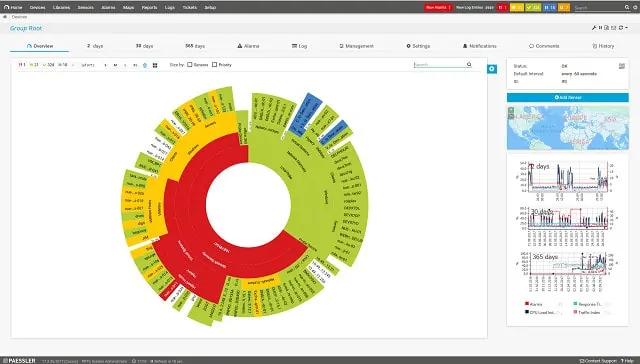
The dashboard of PRTG includes charts and dials to help you see statuses quickly. Alert conditions show up in red, which makes them easy to spot. Alerts can be sent to you by email notification or SMS message. You can also decide which team member receives alerts for specific data sources or alert types. It is also possible to customize the dashboard to give different team members access to different functions. The reporting tool provides a good source of presentation material when you are called upon to explain the capacity of the system and its ability to take on new requirements.
Pros:
- A great option for businesses looking to also implement monitoring for their applications and servers alongside their network
- Highly customizable sensors allow administrators to build their own custom solutions
- Dozens of sensor templates support some of the most popular applications and devices
- Autodiscovery maps out the network and pulls performance metrics right away
Cons:
- PRTG is a highly detailed platform that requires time to fully explore all of its features
The PRTG system ships with a large number of "sensors." Each condition on a network is monitored by one of these sensors. For example, the package includes a Ping sensor, a packet sniffing sensor and a NetFlow sensor. You don't have to turn all of the sensors on, so the PRTG system can be tailored to cover just one aspect of your infrastructure. The service is charged according to the number of sensors that you activate. PRTG is free if you only need to monitor up to 100 sensors. You can get a 30-day free trial of PRTG with unlimited sensors.
Paessler PRTG Network Monitor Download FREE 30 day Trial at Paessler.com
4. ManageEngine OpManager Plus

OpManager Plus combines a network device monitor and a bandwidth analyzer with a server and application monitor, an IP address management system, a switch port manager, and a configuration manager. This is a very comprehensive infrastructure administration tool, but it is particularly the device monitor and the bandwidth analyzer modules that will assist you with your network capacity planning activities.
The network monitor module is available to buy as a separate module, called OpManager and you can also buy the NetFlow Analyzer separately. If you buy these two modules, they will integrate together because they were built on a common platform that facilitates data interchange. All ManageEngine products run on Windows or Linux.
The network device monitor module includes a discovery function that will map your entire network, recording the statuses of each device. This utility is able to reach over the internet to log Cloud-based servers and the remote sites of a WAN. The discovery process also covers wireless network equipment and the connections between hardware and services that form virtualizations.
The discovery process keeps running throughout the service life of OpManager Plus, giving live updates on statuses. The monitor uses the SNMP protocol, which allows device agents to send alerts to the central controller. Alert conditions include warnings when a piece of network equipment is approaching its bandwidth capacity, so you can avert device overloading, or implement queuing. All data gathered by the network device monitor and the bandwidth analyzer can be stored for use in analysis and capacity planning.
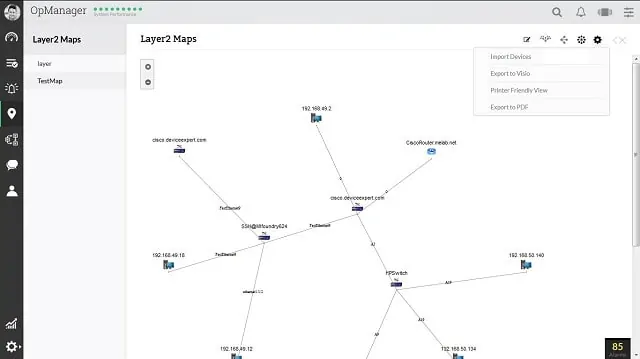
The device inventory forms the basis of a network mapping module, which plots all of your switches, routers and wireless APs automatically, showing the links between them. You can filter the map to show just switches, or just routers and you can also get your WAN devices plotted on a world map. That map includes a zoom option so you can examine all of the devices on an individual site. You can choose to have each device label show the hostname, MAC address, or network IP address. Other mapping options include a server cabinet view and a server room layout plan.
SNMP gives device bandwidth utilization data and the bandwidth analyzing module of OpManager Plus gives greater detail on traffic flows across each link on your network. The analyzer can collect network traffic statistics reported by the NetFlow, IPFIX, jFlow, NetStream, sFlow, cFlow, AppFlow, and FNF device messaging systems. The metrics that arise from these messages are shown live on screen and can also be stored for analysis and capacity planning. The bandwidth utilization data can also be used to support alerts that look for capacity exhaustion.
Data is shown in the dashboard both as lists and as graphical elements, such as dials, graphs, and charts. The title band of the dashboard screen can be used as a summary strip, showing small icons of color-coded graphs that show live data. Each icon acts as a link to a detail screen for the metric that it represents. The dashboard can be customized and you can set up user roles and accounts, giving limited controls and data views to different team members. The dashboard can also be accessed remotely from mobile devices.
Both the charts and maps as well as data lists can be printed out as reports. The live data and stored historical records can be filtered and sorted to help your management and capacity planning activities. A Ping function will track the packet loss rate on each link of your network to help you adjust capacity data. You can also implement IP SLA in the monitor to measure performance metrics such as jitter, latency, Mean Opinion Score, and packet loss. The bandwidth analyzer will also report on round-trip time on connections to remote facilities. Data and map displays can be filtered by application or port number/protocol activity.
The analyzer integrates the Cisco Network Based Application Recognition (NBAR) methodology to segment traffic data. It is also capable of implementing and monitoring traffic shaping and VLAN tagging methods, including Access Control Lists (ACL) and Quality of Service (QoS). OpManager Plus is able to use Class-Based QoS to help you prioritize traffic through queuing policies.
A special Capacity Planning section in the dashboard gives you time-based bandwidth utilization graphs and supports your planning for natural traffic growth through predictive functions. Capacity figures get collected around the clock and seven days a week, so you can examine out of hours activity to find periods suitable for processor-intensive batch jobs. These planning services include some great graphics to ease the capacity planning process.
Pros:
- Can monitor bandwidth consumption as well as alert to configuration changes that could impact network performance
- Can monitor bandwidth and resource consumption on the application level, and even drill down to identify specific users consuming the most resources
Cons:
- Takes time to full explore the all the options available in the ManageEngine software suite
ManageEngine offers all of its products on a 30-day free trial. You can use the standalone network device monitor, which is called OpManager, for free to monitor up to 10 devices.
5. Nagios XI
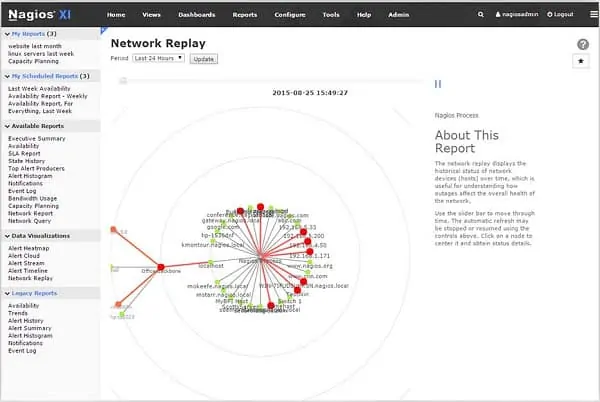
Nagios XI is an infrastructure management package that covers networks and servers. The processing engine of Nagios is an open-source project. You can use it for free in the guise of Nagios Core. This free tool doesn't have a very good interface, however, and you won't find much support for analysis and capacity planning in it. In order to get a better dashboard, you would either have to research other analysis tools that are compatible with Nagios or upgrade to the paid Nagios product, which is Nagios XI.
Nagios XI runs on RHEL and CentOS Linux. It isn't available for Windows, but you could get it on a Windows environment by running it through a virtual machine (VM). The command center can communicate with devices running non-Linux operating systems and firmware and it can also monitor virtual environments. The monitor extends to remote locations, Cloud servers, and wifi systems.
Unlike the other network tools on this list, Nagios doesn't use SNMP to monitor network devices. It has its own proprietary method built into the Nagios Core engine, which communicates with devices to gather status reports. The metrics that are gathered regularly by the monitor appear as live data in the dashboard and you can also opt to store data for analysis later. The Nagios community is a forum where you can pose questions and get tips from other Nagios users. Many users produce their own modules for Nagios because the system can be extended by plug-ins. There is an SNMP plug-in available from the community if you want to stick to this industry-standard monitoring method rather than the default Nagios monitoring routines.
The types of data that you can monitor with Nagios include device capacity, bandwidth usage over time, and packet loss on each link. The interface includes a capacity trend graph that shows you how data throughputs and system usage has expanded over time, continuing on to predictions of future capacity needs.
Nagios XI maintains a device inventory and presents you with a network map, which is drawn automatically. The map and all data can be set to replay traffic data during your capacity planning exercise. This enables you to see the network's capacity performance over several days at one time.
The dashboard is completely customizable. When you buy Nagios XI you get a package of widgets. You pick a widget and place it on the dashboard canvas, thus producing your own layout that features the metrics that are important to you. You can create several versions of the dashboard and allocate them to user roles. You are also able to set up user accounts for access to the Nagios system and you allocate a role to each account. This enables you to create different views and controls for the network and allocate those dashboards to different team members.
Nagios XI includes some pre-written report formats, but you can also create your own layouts in a reporting tool that is included in the package. The graphs and other data visualizations, such as the network plan, can all be printed out to provide you with presentation material to support collaborative decision making.
Pros:
- Is open-source and completely free, with a paid option for enterprises
- Supports autodiscovery for easy device management
- Can monitor devices through an additional agent
Cons:
- User interface is lacking, could be easier to use and feature more customizable looks
- Network mapping visualizations need improvement
- Must pay extra for support
You can try out Nagios XI before you invest any of your company's money in the system by taking up a 60-day free trial. Nagios XI is available in two levels of service. The pre-written capacity planning capabilities are only included with the higher service level. However, you could create your own capacity planning reports or look for free planning add-ons from the community if you opt for the cheaper version of the tool.
6. WhatsUp Gold with Network Traffic Analysis add-on

WhatsUp Gold is a network monitor that focuses on the health of network equipment. The company that produces WhatsUp Gold, Progress (formerly Ipswitch), created a series of add-on modules that integrate into its main product. One of these, the Network Traffic Analysis Add-on will give you data about traffic flow across network links. Both of these software packages run on Windows Server.
When you install WhatsUp Gold it will search the network and record all of the network devices. The system builds up an inventory of your network devices, including their bandwidth capacity. The software will automatically draw up a network map from this information.
The WhatsUp Gold monitor continues to query all devices to get an update on their statuses. This includes the amount of throughput that each device is handling. The information derived from these queries gets updated in the equipment inventory and also gets reflected in the network map. An extra benefit of this process is that you don't have to update the inventory or redraw the map if you add or remove devices. Each piece of equipment in the network map is shown as a round icon. The edge of the disk is color-coded to show the health of the device that it represents. If the device approaches its full capacity, that circle will turn red.
The links drawn on the network map are also color-coded. Those statuses are gathered by the Network Traffic Analysis add-on. This module receives traffic metrics from network devices via a number of messaging protocols. These are NetFlow, NetFlow Lite, IPFIX, jFlow, sFlow, and QUIC.
The main WhatsUp Gold package and the Network Traffic Analysis add-on will provide you with all of the information on existing traffic capacity and utilization for your capacity planning exercise. If you need to run a test of the new applications that you want to add to the network, you can use the CBQoS and NBAR capabilities of the Network Traffic Analysis module to track its traffic patterns.
For analysis and capacity planning, the traffic monitor presents data that can be sorted, filtered, and aggregated to show you the capacity of each link and network device. These traffic patterns can be derived from live data as well as historical data. This shows the peak traffic events on each network element. You can apply analysis to a group of devices, which enables you to focus just on the areas of the network that will be affected by new projects.
Pros:
- Great interface
- Supports a wide range of flow enabled devices
- Can support both virtual and physical hardware
- Balances user experience with monitoring features quite well
Cons:
- Only available for Windows operating systems
- Free version can only monitor up to five resources
The WhatsUp Gold system ships with standard reports that show traffic by a range of different attributes. These reports can show a league table of the top sources of traffic by software package, application, protocol, or IP address. Data in the dashboard is represented in lists and also in graphical content such as line graphs, charts, and dials. The data presentation features of this software will help you explain the network status to non-technical staff. You can get a 30-day free trial of WhatsUp Gold and the Network Traffic Analysis add-on to put them through their paces.
Choosing a Network Capacity Planning Tool
All the tools suggested in this list are produced by vendors with long-standing in producing tools for network monitoring, so any decision among a tool will come down to features and pricing. All tools in the list come with good documentation and ongoing support.
If you are a smaller organization, you might want to test the waters with the SolarWinds Flow Tool Bundle which is totally free and may suffice for your network requirements. If you outgrow this tool bundle or simply need more power, the SolarWinds Network Analyzer Pack offers a free trial period, as do Paessler with their PRTG Network Monitor.
Do you use network monitoring tools that give you capacity planning support? Which is your favorite tool? Have you tried and rejected other network planning software that isn't on our list? Do you recommend any of the systems that we have featured in this guide? Let us know about your experience by leaving a message in the Comments section below.
Network Capacity Planning FAQs
What is network capacity planning?
Network capacity planning is a process through which you estimate the requirements for the network in terms of data throughput carrying capabilities. This consideration should examine traffic patterns end-to-end between two nodes on the network selected in turn and also on each link.
How do you determine the capacity of your network?
The straightforward way to identify the capacity of your network is to note down the full capacity of each switch and router on your network and also the throughput capacity of the cable you use. The lowest of these numbers is your maximum network capacity because it represents a bottleneck.
How is network capacity measured?
Network capacity is also known as bandwidth. The capacity is measured as the maximum number of bits that pass through each switch and router per second. You can read off the data throughput rate live from the console of each network device. However, the capacity of each device is fixed by its physical structure. This number will be visible in the device's console and it will also be printed on the spec of the device.
Network Planning And Design Tools
Source: https://www.comparitech.com/net-admin/network-capacity-planning-tools/
Posted by: beckerstroardlean.blogspot.com

0 Response to "Network Planning And Design Tools"
Post a Comment